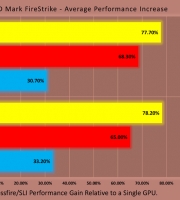

Sata Express – A Side Note.
2014 was a transitional period of terabyte tyranny and there were no drives with which to showcase the spoils of Sata Express, at least not for us. Asus had been vociferously approving the protocol from its inception and Results derived from their “Hyper Drive”, demonstrated in April the same year, saw it overhaul the velocity of vanilla SATA III by almost a third, though how it would fair long term against its cable free rival and what impact searingly pacy slot based SSDs were to have on both, or weather the two could peacefully co-exists were tales told in another era. Fortunately, the connector doubled up to the avail of two standard SATA drives.
EVGA X99 Classified/MSI X99s Gaming AC
Support for 4 way SLI with every Haswell-E processor, including the popular baby bear. There were rumours that the 5820K with its frugal 28 lanes could only organize a 3 way pixel party, but the bountiful bandwidth (32GB/s) accompanying PCI-E’s 3rd incarnation married to a logical designation of resources proved more than adequate.
Of course, 4 way SLI was next to useless due to poorly developed drivers and latency issues but an additional PCI-E 3.0 x4 slot for those who had chosen not to enlist mummy or daddy bear still offered numerous excuses to sensibly squander the remaining budget. Hospitality for a Mushkin Scorpion? Or an advanced video production card from the likes of Black Magic. What else? Use your imagination, I’m a weary man.
Asus X99-WS
Outstanding scope for expansion. Seven senior slots and a double dusting of multiplexing magic (two PLX PEX8747s) meant this monster could appear to muster 64 PCI-E 3.0 lanes irrespective of the processor installed and that every slot could be populated without compromise.
“If PCI-E x4 Slot1 is occupied, then USB 3 headers 1 and 2 will be disabled. If PCI-E x4 slot 1 is occupied by custard or treacle, then a Door mouse will delete your steam account ….and so on. No such worries with an Asus Workstation.
The first and last to grace my cases at length, and only in light of my subsequent longing for dual delectation, was The P6T7 “Supercomputer” in 2009. For three years this gallant x58 galleon, a worthy Westmere manning its mast, nobly negotiated savage seas of primes, pixels, frames and wavs.
There were no fancy PLX Chips back then, only old Green Eyes’ infernal elder, the NF200, of which he housed two, but their mission to optimize the management of PCI-E bandwidth was identical to that of their cooler, more efficient descendants.
EVGA’s maiden Classified, another x58 laden flagship was unveiled the same year, and also harboured one of these meaty multiplexors. I had the good fortune to own both.
The Classified was a limited edition enclosed with a a certificate of authenticity, intended to ignite in the the customer an intoxicating feeling of pride and regality similar to that invoked by Luis Vuittons luggage.
Despite this valuable accoutrement, the board’s eSATA port ceased to be within a year and when EVGA’s traditionally impeccable support team failed to find fault, it was to overwhelming fickleness that I gave way.
The conservative heat sink on the P6T7 was hauntingly reminiscent of that observed here and decidedly apt in placating the verdant flames beneath. I don’t recall a single crash that wasn’t accounted for by slack software, defective drivers or a virulent virus. Two and 3 three way SLI were as smooth as Egyptian cotton, exhibiting none of the latency penalties habitually attributed to the NF200 bridge.
Not a single stick of memory ever needed replacing and all ports and slots functioned flawlessly for the duration of its reign. Why do I so forcibly recount stories of tenuous relevance?
Bullet points and present tense alert…